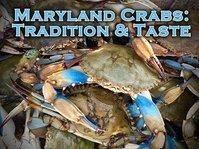Maryland Crabs: Tradition & Taste

Ask just about anyone what comes to mind when you mention Maryland, and they’ll probably say “you know, crabs.” What they really mean is the iconic, hardy, blue-green Chesapeake crustacean known to scientists as Callinectus Sapidus -- and to the rest of us by a bunch of other names: blue crabs, jimmies, sooks, sallies, peelers, v-bottoms and sponge crabs. No matter what they’re called, if they’re fished out of Chesapeake waters, they’re most likely destined for a dinner plate as a crab cake, or a paper-lined table to be hammered, cracked and picked on a summer’s day.
This is the way things have been for as long as men and women have caught the wily Blue Crab out of the Bay and the rivers that feed North America’s largest estuary. People love to eat crab and watermen are happy to catch and sell them. An entire industry grew out of this arrangement between fisher and eater, one that’s become a modern and vibrant economic engine for locals who work the water, and for the others who earn a living from its crab bounty. But times are changing, and things are shifting.
Facing some new and unexpected challenges, the blue crab industry feels a bit tentative as it looks to the future. From watermen and waterwomen working their trot lines and pulling their crab pots, to processing houses dotting the banks of the bay, uncertainty is today’s watchword for an industry that has worked largely behind the scenes and out of the public eye. From labor shortages in processing facilities to crab harvest declines, international competition and water quality issues, the waterman is facing a barrage of unforeseen and difficult challenges.